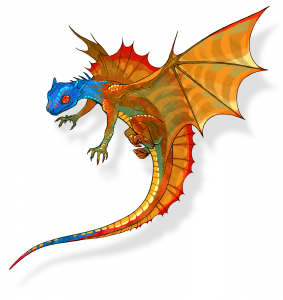An essay by Dr. Henrik Ahlstrom, as provided by Dantzel Cherry
Art by Leigh Legler
DR27-6 wobbles one last time, and a crack laces across the marble shell, etched by a small egg tooth. White and red fluids spill out. The tooth saws back and forth a few times, then stops.
I dim the lights and wait.
Another few moments and an azure head pops out–a male, then. His slanted copper eyes shift around the room.
He’s calm, which means he hasn’t recognized me as a threat yet. I know the cameras and monitors are at work, so I wait patiently. One step onto the heated rocks, then four more in quick succession for the rest of his body to be free.
Something threatens him–the basking bulb, presumably–and he releases FPI44. Moving at such high pressure from the oral glands, the FPI44 compound bursts into flames and I measure seven inches. I suppose that makes DR27-6 the fiercest, strongest specimen in this round of the project, but this is not enough to get my hopes up. He will likely end up like the rest. His fierce eyes, though … they burn with life.
The blue on his head spreads downward and shares space freely with marigold until intermixing with crimson on the sailfin. His wings are beautiful, and functional–at least in theory. They’re useless in the first few hours of life. Once we engineered functional wings in stage 2, we added the gene expression inhibitor to turn off the God-given poison production in the oral glands, and added the FPI44 gland specific inducer in stage 3, which doesn’t agree with the neurons required for flight. I convinced Tom to speak with Monsieur Benefactor about being content with flying, non-fire-breathing dragons, but Monsieur was quite insistent.
Officially we name them with sterile, passionless identifications such as DR27-6, so that’s what I record for Tom and the herpetologists. But alone in the basement like this, wild eyes glaring at me, he is more. DR27-6 is Fafnir, the strongest dragon of them all.

The blue on his head spreads downward and shares space freely with marigold until intermixing with crimson on the sailfin. His wings are beautiful, and functional–at least in theory. They’re useless in the first few hours of life. Once we engineered functional wings in stage 2, we added the gene expression inhibitor to turn off the God-given poison production in the oral glands, and added the FPI44 gland specific inducer in stage 3, which doesn’t agree with the neurons required for flight.
To read the rest of this story, check out the Mad Scientist Journal: Spring 2017 collection.
After earning a PhD in Cell and Molecular Biology from Stanford University, Dr. Henrik Ahlstrom completed a post-doc at University of Virginia Center for BioTechnology and another at Scripps Research Institute as the primary investigator for the groundbreaking paper, Directed Induction of Foreign Tissue Growth in any Eukaryotic Host. After a short stint as Chief Scientific Officer for Bilon Therapeutics, he has since been involved in an undisclosed research project for a private laboratory in Belgium.
Dantzel Cherry teaches Pilates and raises her daughter by day. By night and naptime, she writes. Her baking hours follow no rhyme or reason. Her short stories have appeared in Fireside, InterGalactic Medicine Show, Galaxy’s Edge, and other magazines and anthologies.
Leigh’s professional title is “illustrator,” but that’s just a nice word for “monster-maker,” in this case. More information about them can be found at http://leighlegler.carbonmade.com/.
“Birthing Fire” previously appeared as the 2nd place winner in the Story Star Publishing Short Story Contest in 2012.
“Birthing Fire” is © 2012 Dantzel Cherry
Art accompanying story is © 2017 Leigh Legler
